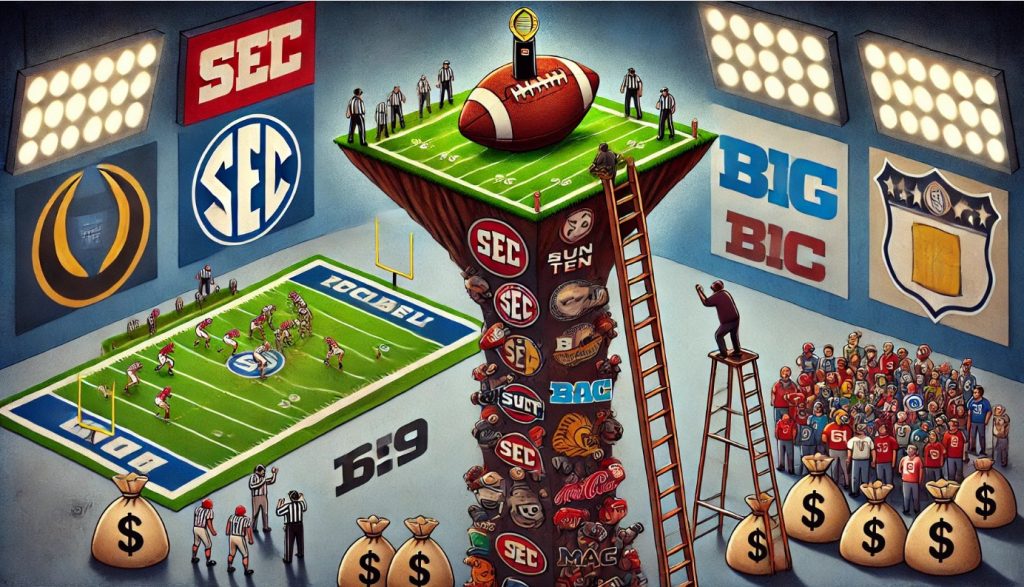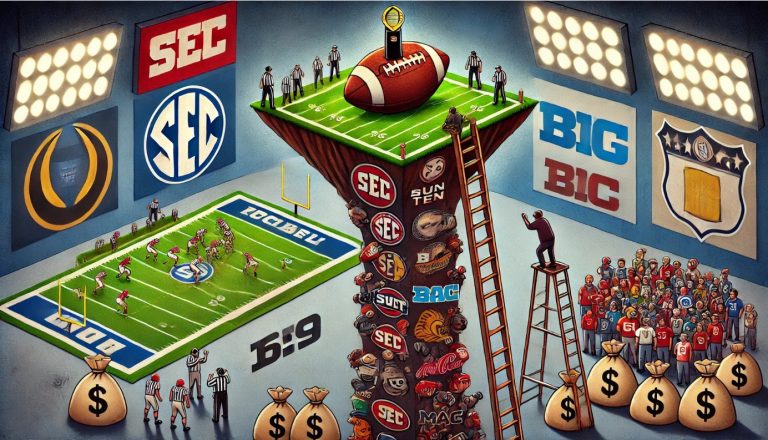
By Larry Billinger
Football fans across the country are getting weary of the same powerhouses hogging the spotlight in the playoffs. It’s a bit like seeing the same old movie over and over—sure, it’s fun the first time, but it loses its spark after a while. So, I cooked up a fresh bracket idea that might turn the college football world upside down—hopefully in a good way.
SEC Bias? Big Ten Bias? Let’s Chat!
We all know the Southeastern Conference (SEC) and the Big Ten rake in loads of cash from TV deals. They also have giant fan bases, meaning they often slide three or four teams into the playoffs. Of course, those squads are talented, but it feels unfair when other conferences get brushed aside, like the last slice of pizza nobody wants to claim. My plan is to give each conference a fairer shot: one spot for the champion and a second slot if there’s a great runner-up.
But there’s more to the story than just brand-name favoritism. The College Football Playoff selection committee claims it uses factors like strength of schedule, head-to-head results, and conference championships. As we’ve seen this year, they also lean on a vague “eye test” that favors familiar uniforms and big-time TV draws.
The Magic of Conference Diversity
Here’s my proposed playoff breakdown:
| Conference | Teams in Playoffs |
|---|---|
| American Athletic (AAC) | x1 |
| Atlantic Coast (ACC) | x2 |
| Big 12 | x2 |
| Big Ten | x2 |
| Conference USA (CUSA) | x1 |
| Mid-American (MAC) | x1 |
| Mountain West (MW) | x1 |
| Southeastern (SEC) | x2 |
| Sun Belt | x1 |
| Wildcard | x3 |
Those wildcard slots can go to independent teams like Notre Dame, a Pac-12 standout, or any other squad that might otherwise get overlooked.

Tackling the Seed Problems
Right now, some seeding choices make no sense. A so-called No. 12 team may outrank a mightier conference champ or a 9-3 team might leapfrog an 11-2 team just because the 9-3 squad has a more prominent name. For instance:
- Alabama at 9-3 ranked higher than 11-2 Arizona State. Huh?
- Clemson slipped in as a No. 12 seed despite a 10-3 record in the ACC.
Meanwhile, how did teams like BYU and other Big 12 contenders get left out in the cold so easily? According to a Salt Lake Tribune article by Gordon Monson (Nov. 7, 2024), BYU finished with an outstanding record, including wins over ranked opponents, but ended up overlooked by the committee. That’s downright puzzling—especially when you consider what John Kurtz, a popular YouTuber covering Big 12 football, pointed out: the eye test just seemed to be an excuse to favor recognizable brands over consistent results.
I’m not saying big-name teams shouldn’t have a crack at the playoffs, but we need clear standards. If Arizona State or BYU earned the better record and had more substantial wins, they should be placed accordingly—no more skipping ahead just because of a flashy conference patch on your jersey.
The BYU and Big 12 Snub
A Case Study in Biased Selection
- BYU smashed Colorado in a bowl game before a huge national audience, finishing 11-2 (in many accounts).
- Yet, the committee barely considered them, while some three-loss squads from the SEC and other “prestige” leagues were not just in the mix, they were near the top.
Kurtz highlights how BYU’s wins over ranked opponents were discounted because they didn’t “look” as formidable on film. But if your “eye test” ignores scoreboard results, you might need a new pair of glasses.
This isn’t just about the Cougars. Kurtz also notes that the Big 12 as a whole was treated as an afterthought. At one point, folks speculated that the Big 12 might not get a single playoff team—even if its champion finished with one or two losses. Compare that to how the SEC seemed guaranteed multiple spots, even as some of its members lost big in bowl games.
What the Committee Says vs. What They Do
If you read the official College Football Playoff selection protocol (cfp.com), you’ll see guidelines mentioning:
- Conference Championships
- Head-to-Head Results
- Comparative Outcomes of Common Opponents
- Other Relevant Factors (like injuries and key players missing)
But each year, we hear committee spokespeople throw around terms like “eye test” and “game control,” which nobody can measure. When pressed about why a team like BYU or a strong Big 12 runner-up missed out, the answer usually boils down to intangible vibes, brand recognition, and the lure of big TV numbers. Let’s be honest—that’s not exactly the objective, data-driven approach fans were promised.
Updating My Plan for More Fairness
- Ranking Transparency
- Give us a public scoreboard of how each member voted or a more precise metric of each team’s résumé. If the committee’s leaning on an “eye test,” let us see the specifics.
- Conference Champs Earn Real Rewards
- If you win the Big 12, ACC, Big Ten, or SEC, you shouldn’t have to watch a three-loss team from that same conference get a higher seed. One champion from each significant conference should get in; the second slot from that conference must meet specific criteria (like top-10 in overall rating).
- A More Balanced Wildcard System
- Keep the wildcard idea, but ensure these spots aren’t automatically given to “the usual suspects.” If, for example, the Sun Belt champ is 12-0 with a couple of power conference scalps, they deserve a legitimate chance at glory.
- Ditch the Unfair Eye Test
- We can still watch game films, but let’s incorporate advanced metrics, computer models, and strength-of-schedule data more heavily. Teams like BYU shouldn’t be tossed aside because they don’t have a “blue-blood” tradition.
Wrapping It All Up
My plan isn’t perfect, but I set out to make college football more thrilling and fair. After reading Gordon Monson’s take on BYU’s snub and John Kurtz’s observations on Big 12 bias, it’s hard to ignore how the current system favors specific conferences and brands. An underdog from the MAC or a second-tier Big 12 contender might need the proper bracket chance to stun the world.
Who wouldn’t want a Sun Belt champ toppling a nationally hyped SEC team or an overlooked BYU going toe-to-toe with a Big Ten juggernaut? If you’re a fan of the underdog, you’ll have a blast cheering on the wild upsets that could happen. It’s time to give every conference a real shot at glory—because there’s nothing like fresh blood in the playoffs to keep the sport alive.
References
- Gordon Monson, The Salt Lake Tribune (Nov. 7, 2024)
- John Kurtz, YouTube Commentary (2024 Season Recap)
- College Football Playoff Rankings, cfp.com
- AP Top 25 Poll, apnews.com/ap-top-25-college-football-poll
- NCAA Conference Standings, ncaa.com




